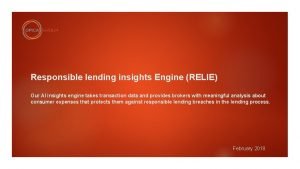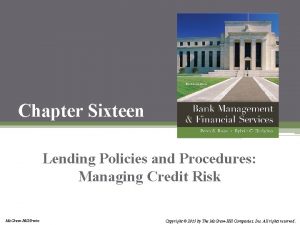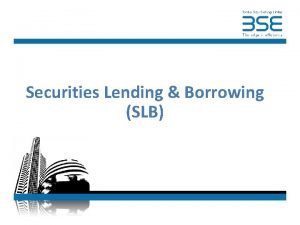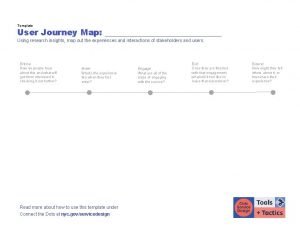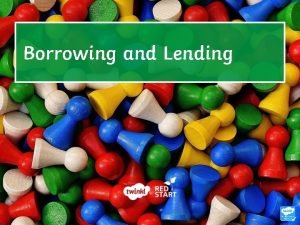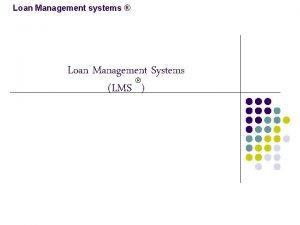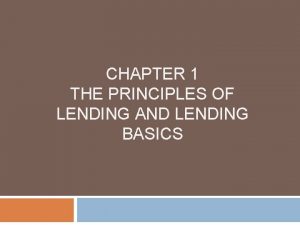On Loan Sales Loan Contracting and Lending Relationships









- Slides: 9

On Loan Sales, Loan Contracting, and Lending Relationships Authors: Steven Drucker and Manju Puri Discussant: Haluk Unal FDIC-CFR Workshop, October 27, 2006

Central Issue How do banks reduce agency problems that arise from selling loans? n How do loan sales affect lending relationships? n

Data n n n Matching the LSTA mark-to-market pricing database (7372 loans May 98/Sep 05) with Deal. Scan (Jan 99/Dec 04) gives 3182 sold facilities among the 24, 823 (13%) Deal. Scan loans. Keep only those loans where Deal. Scan reports the existence of at least one general or financial covenant. The final sample is 7261 facilities of which 1, 075 are sold in the secondary market. Could there be sold loans in the (7261 -1075) sample? Net Worth Sample: 2470 sold 204 not sold. Borrower must maintain a minimum level of net worth or tangible net worth. Current Ratio Sample: 561 loan facilities of which 17 are loan sales. Must maintain a minimum current ratio.

Findings 1. Characteristics of the borrowers of the sold-loans: n Sold-borrowers are over 1. 5 times larger than borrowers whose loans are not sold n 90% of sold-loans have borrowers with a public debt credit rating. 2. Characteristics of the sold-loans n Term-loans are more likely to be sold than credit lines. n Loans originated by lead banks with higher loan market shares are more likely to be sold. 3. Design characteristics of sold loans n More restrictive covenant packages than loans that are not sold and are held by the original banks.

Findings. Impact of design characteristics: 4 Tighter covenants improve the likelihood of selling loans in the secondary market but less impact on facilitating loan syndication (sales at origination). Tighter covenants increase the likelihood of sale when lenders are not reputable. CONCLUSION: Sold loans are structured to reduce buyer-seller agency problem. 4. Impact on borrowers Borrowers whose loans are sold are growing companies with high leverage ratios. During the origination year of the sold loan, private debt issuance more than doubles increasing firms’ interest-bearing debt levels and leverage ratios. Loan sales increase relationship durability for risky borrowers. Loan selling improves lending relationships when lenders have more reputational capital at risk. CONCLUSION: Borrower benefits from loan sale.

Front-end of the paper: Tradeoffs in choice of covenants n Pricing: n n Lender: n n Reputation vs. number of covenants. Borrower: n n Lower yields vs. higher number of covenants. Number of covenants might increase the likelihood of sale but does it cost the lender? High number of covenants vs. improved relationship. Optimization of the number of covenants?

What do these Covenants look like? Max Debt to EBITDA Min Fixed Charge ratio Min (tangible) net worth Min Interest Coverage Max Capital Expenditure Min EBITDA Max Leverage Ratio Max Senior Debt to EBITDA Max Debt-to-Tangible NW Min Debt Service Coverage Min Current Ratio Min Quick Ratio Min Cash Interest Coverage Max Debt-to-Equity Max Senior Leverage Max Loan to Value n Quality differences, repetitions. For example, why would one add Max Debt-to -Equity and Maximum Leverage Ratio over and above Max Debt to EBITDA? What is the cost?

Further Questions n n Sold loans have 3. 4 covenants as opposed to only 2. 7 covenants for loans that are not sold. Furthermore, an increase in the number of covenants from 2. 1 to 3. 1 increases the probability of selling loans 12. 41%. One could say what is one additional covenant between friends? Adding Max leverage to Max debt-toassets has this impact? Any non-linearity? Reputation: Covenant package is an important determinant of loan sales than lender reputation. Is there a trade-off here? Do low reputation lenders have high number of covenants? Cost of including covenants? Reduced flexibility. Okay, that’s fine but then can we show whether loan rates differ as we increase the number of covenants? There should be some sort of an explicit cost of including covenants. Otherwise, since it is such a good thing. (since the paper shows that more covenants lead to higher probability of sale and loan sale benefits the borrower and lender) why not increase the number. If these covenants have such importance then it should be priced somehow.

Suggestion Change the title On Loan Sales and Covenants n Introduce Lending Relationship section part of the tradeoff analysis. n Expand Covenants discussion (more institutional information, pricing, etc. ) n
 Sales organization structures
Sales organization structures Discuss the nuances of sales letters.
Discuss the nuances of sales letters. Sales deployment
Sales deployment Clover leaf routing plan
Clover leaf routing plan Relie responsible lending and insights engine
Relie responsible lending and insights engine An institution for receiving, keeping, and lending money
An institution for receiving, keeping, and lending money Lending policies and procedures managing credit risk
Lending policies and procedures managing credit risk Securities lending and borrowing example
Securities lending and borrowing example Relie responsible lending and insights engine
Relie responsible lending and insights engine Relie responsible lending and insights engine
Relie responsible lending and insights engine




